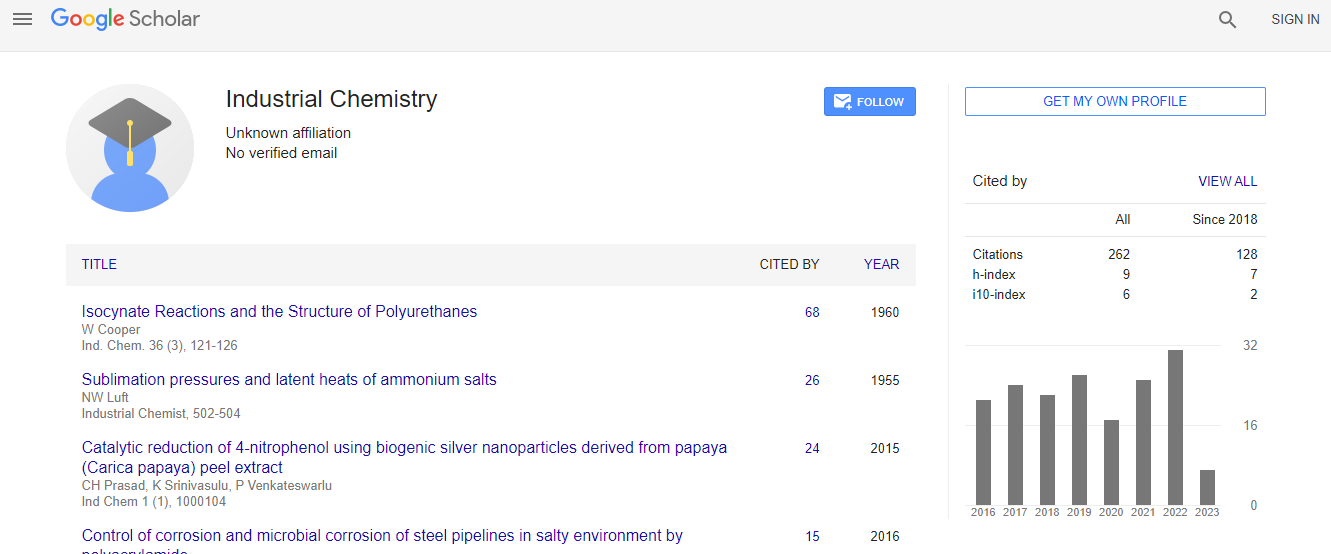Our Group organises 3000+ Global Conferenceseries Events every year across USA, Europe & Asia with support from 1000 more scientific Societies and Publishes 700+ Open Access Journals which contains over 50000 eminent personalities, reputed scientists as editorial board members.
Open Access Journals gaining more Readers and Citations
700 Journals and 15,000,000 Readers Each Journal is getting 25,000+ Readers
Google Scholar citation report
Citations : 262
Industrial Chemistry received 262 citations as per Google Scholar report
Indexed In
- Index Copernicus
- Google Scholar
- RefSeek
- Directory of Research Journal Indexing (DRJI)
- Hamdard University
- EBSCO A-Z
- OCLC- WorldCat
- Scholarsteer
- Geneva Foundation for Medical Education and Research
- Euro Pub
Useful Links
Recommended Journals
Related Subjects
Share This Page
Emerging ├Å┬? conjugated stretched and contacted helices of substituted polyacetylenes prepared with an organo-rhodium catalyst
17th International Conference on Industrial Chemistry and Water Treatment
Masayoshi Tabata
Muroran Institute of Technology, Japan
Keynote: Ind Chem
Abstract
The highly stereo-regular preparation of mono-substituted polyacetylenes (SPA)s was performed using an [Rh(norbornadiene)Cl] 2-triethylamine catalyst to give the ├Å┬?-conjugated helical polymers, because, the SPAs are expected as new advanced materials due to semi-conductivity, NLO properties, external stimulus responsibility, enantioselectivity, and oxygen permeability. These properties are strongly related to the geometrical structure, e.g., cis or trans forms and higherorder structure, e.g., ├Å┬? stacking along with the helical main-chain in the solid phase. Therefore, we have investigated whether the geometrical and helical structures of the SPAs can be controlled through molecular design and/or external stimuli. The p-n-hexyloxyphenylacetylene (pPA) monomer was stereo-regularly polymerized using the Rh catalyst at 25├?┬░C. When ethanol and n-hexane were used as the polymerization solvents, a yellow P(Y), and its red P(R) were obtained, respectively. The diffuse reflective UV-vis spectra of these polymers showed ├?┬╗max at 445 and 575nm, respectively. The WAXS patterns of P(Y) and P(R) exhibited hexagonal columnar structures which were attributed to the stretched and contracted helices, respectively. Additionally, P(Y) was irreversibly transformed into a reddish-black P(Y├ó┬?┬?B), whose columnar diameter was identical to that of P(R) when heated at 80├?┬░C for 1h. These findings suggest a thermally irreversible rearrangement from a thermally unstable P(Y) with a stretched helix to a stable P(Y├ó┬?┬?B) with a contracted helix. In the case of aliphatic polyacetylene ester, the mutual helical oscillation between the contacted and stretched helices was found in the solution.Biography
Masayoshi Tabata has completed his PhD from Hokkaido University, Japan and Post-doctoral Fellowship from United Kingdom and Sweden. After that, he became an Assistant Professor and Associated Professor at Hokkaido University, and Professor of Muroran Institute of Technology, Japan. Furthermore, he also became a Senior Research Director at National Institute of Advanced Industrial Science and Technology (AIST) at Tsukuba, Japan, and Guest Professor at Paris University in France.

 Spanish
Spanish  Chinese
Chinese  Russian
Russian  German
German  French
French  Japanese
Japanese  Portuguese
Portuguese  Hindi
Hindi 